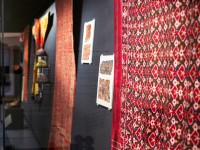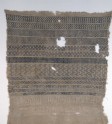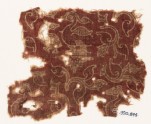Room 5 | Textiles gallery
Explore the beauty and variety of Eastern Art objects on display in the Textiles gallery.

The Role of Textiles in Cross-Cultural Exchange
'The principle riches consist chiefly of silk and cotton stuffs, wherewith everyone from Cape of Good Hope to China, man and woman, is clothed from head to foot.'
(The French traveller François Pyrard writing from Goa, India, early 1600s)
Textiles are among the most important manufactured goods to move between cultures. Their ultimate fragility sometimes lets us forget that they start out far more durable than ceramics and glass, and they are of course more portable. In the Ancient Mediterranean world, linen and wool textiles were traded between Egypt, Greece, and Italy. Fashionable ladies in Ancient Rome dressed in Chinese silk.
Chinese textile designs also influenced the arts of Persia and Byzantium. Indian painted and printed cotton textiles were in demand in East and West alike, so much so that they became the most widely accepted currency of exchange in the Indian Ocean spice trade.
 Silk patolu cloth (EA1962.13)
Silk patolu cloth (EA1962.13)
 Coverlet with diamond-shapes containing medallions and protruding hooks (EA1978.114)
Coverlet with diamond-shapes containing medallions and protruding hooks (EA1978.114)
 Sampler fragment with band of script, chevrons, and squares (EA1984.488)
Sampler fragment with band of script, chevrons, and squares (EA1984.488)
 Textile fragment probably imitating patola pattern, with diamond-shapes and crosses (EA1990.1025)
Textile fragment probably imitating patola pattern, with diamond-shapes and crosses (EA1990.1025)
 Textile fragment probably imitating patola pattern, with diamond-shapes and squares (EA1990.1026)
Textile fragment probably imitating patola pattern, with diamond-shapes and squares (EA1990.1026)
 Textile fragment with hamsa, or geese, and quatrefoils (EA1990.807)
Textile fragment with hamsa, or geese, and quatrefoils (EA1990.807)
 Textile fragment with leaves, hamsa, or geese, and quatrefoils (EA1990.844)
Textile fragment with leaves, hamsa, or geese, and quatrefoils (EA1990.844)
 Cloth with hamsa, or geese, lotus buds, and rosettes (EA1995.61)
Cloth with hamsa, or geese, lotus buds, and rosettes (EA1995.61)
Notice
Objects may have since been removed or replaced from a gallery. Click into an individual object record to confirm whether or not an object is currently on display. Our object location data is usually updated on a monthly basis, so contact the Jameel Study Centre if you are planning to visit the museum to see a particular Eastern Art object.
© 2013 University of Oxford - Ashmolean Museum
